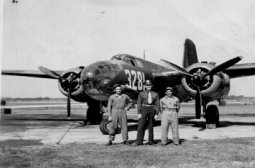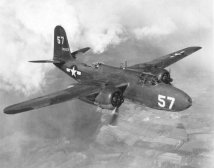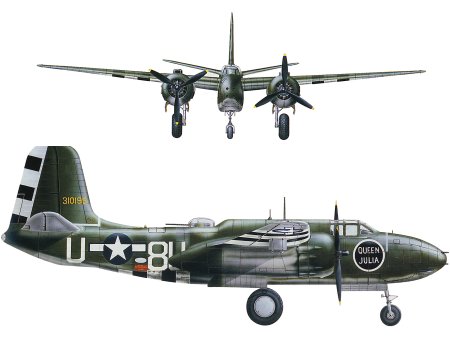
Home »
USA » Douglas A-20 Boston/Havoc
Douglas A-20 Boston/Havoc
When designers Jack Northrop and Edward Heinemann designed the Douglas DB-7 in 1938, the idea of a twin engined attack bomber with tricycle gear seemed futuristic. Although considered very advanced when it was purchased by Britain in 1940, it was no match for top fighters like the Spitfire and Bf 109. Known as the Boston in RAF service, it was used as a bomber and as a carrier for Turbinlite, a searchlight used to illiminate Luftwaffe warplanes by night for RAF Hurricanes to stalk.
As the A-20 Havoc the aircraft entered service with US Forces as a heavily armed attack bomber. Havocs saw a lot of service. They ranged far and wide over the Pacific, strafing and bombing in the war against Japan, and supplied devastating fire support for the Normandy landings of June 1944. They were also popular with the Soviet air force, which was the largest user of the type. The P-70 night fighter version and the F-3 Havoc reconnaissance craft were used mostly for training and saw limited combat.
During World War II the Douglas A-20 Havoc, called Boston by the RAF, fought on every continent and in every theatre of the war. It was not the fastest plane in its class, but it was extremely tough, handled well and was a popular and effective fighting machine, especially in the low level attack role. Pilots knew they could fly the A-20 much like a fighter, inflicting considerable damage on their adversaries in the process.
 |
 |
 |
| The Douglas A-20 was greatly feared by the enemy as it combined speed, agility and a hard hitting weapon load. It successfully fulfilled many roles that it was never designed to undertake. |
The narrow fuselage of the Douglas A-20 is apparent when seen from ahead. The shape gave speed and agility but restricted the movement of the navigator and gunner. |
The hard hitting Boston Mk III could be armed with 27 kg (60 lb) rockets. The great strength of all the A-20 variants was their versatility in accepting almost any armament. |
|
Douglas A-20 Boston/Havoc (Technical Specification) |
| Role |
Two or three seat light attack bomber |
| Manufacturer |
Douglas |
| Maximum Speed |
546 kmh (340 mph) |
| Maximum Range |
1,754 km (1,087 miles) |
| Ceiling |
7,865 meters (25,800 feet) |
Weight
Empty
Maximum Takeoff |
7,250 kg (14,950 lbs)
12,338 kg (27,144 lbs) |
Dimensions
Wingspan
Length
Height
Wing Area |
18.69 meters (61 ft)
14.63 meters (48 ft)
5.36 meters (18 ft)
43.11 square meters (464 sq ft) |
| Engines |
Two Wright R-2800-23 Double Cyclone radial piston engines each providing 1,193-kW (2,625 hp) |
| Armament |
Six forward firing 12.7 mm (0.50 cal) machine guns in nose
Two 12.7 mm machine guns in nose
Two 12.7 mm machine guns in power operated dorsal turret
One manual 12.7 mm machine gun in the ventral position; up to 1,814 kg (3,990 lbs) of bombs
|
Photo Gallery
Click here to submit your photo
| Have A Passion For Aircraft? |
Subscribe to our 14 series FREE newsletter
delivered weekly on World War 2 Aircraft factfile... |
| NB:- We hate spam as much as you do, so your email address will NEVER be shared with or sold to anyone else. That's a Guarantee. |
|
|







